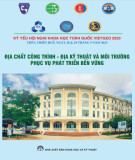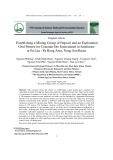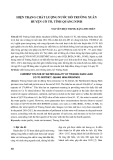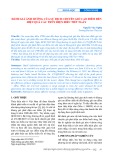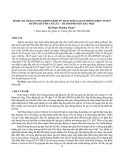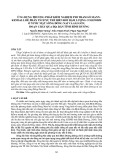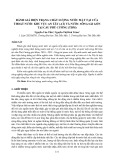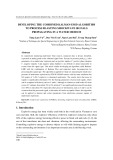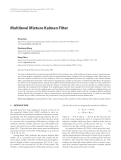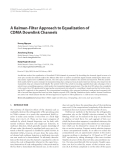
Section on Special Construction Engineering - Vol. 07, No. 01 (Jun. 2024)
100
DEVELOPING THE COMBINED KALMAN-EMD ALGORITHM
TO PROCESS BLASTING SHOCKWAVE SIGNALS
PROPAGATING IN A WATER MEDIUM
Tung Lam Vu1,*, Duc Viet Tran2, Ngoc Lam Bui3, Trong Thang Dam1
1
Institute of Techniques for Special Engineering, Le Quy Don Technical University, Hanoi, Vietnam
2
General Department of Defence Industry, Hanoi, Vietnam
3
X28 Factory, Haiphong, Vietnam
Abstract
In experiments deploying underwater blast sensors, measured data is always disturbed,
expressed as analog peaks in the obtained signal form. Except for pressure peak pmax, other
parameters of an underwater explosion such as positive impulse I+, positive phase duration
τ+, negative impulse I- and negative phase duration τ- are difficult or almost impossible to
extract from this signal type. This article studies developing an algorithm called Kalman-
EMD with the combination of Kalman filter and empirical mode decomposition for
processing this signal type. The algorithm is applied in 6 data sets measuring the shockwave
pressure of underwater explosions by PCB W138A05 sensors with the same condition that
184 grams of A-IX-2 explosive is detonated underwater. The results show that noise in
signals is significantly eliminated. For the blasting parameters of processed signals, which
can be compared with theory such as I+ and τ+, although it witnesses a small trade-off when
errors of I+ enhance from about 3% to 6%, errors of τ+ are significantly decreased from about
over 30% to only about 3%. Especially other pieces of information, such as I- and τ- can be
extracted from the processed signal, so this trade-off can be acceptable. Hence, this algorithm
can be applied to denoise and extract parameters from shockwave pressure signals of
underwater explosions.
Keywords: Underwater explosions (UNDEX); denoising; Empirical mode decomposition (EMD);
Kalman filter.
1. Introduction
Explosive energy has been widely used both in the world and in Vietnam to save
costs and time. Still, the explosive efficiency of the best explosives today has only about
20% of the explosive energy becoming effective power to break soil and rocks [1, 2], the
rest of that transforms into heat and vibration, affecting the surrounding environment.
Controlling explosive energy to destroy objects at will while limiting negative impacts
on the surrounding environment is an important research area in the blasting work.
*Email: lamvt@lqdtu.edu.vn
DOI: 10.56651/lqdtu.jst.v7.n01.833.sce





